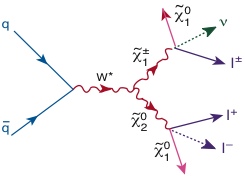| |||||||||||||||||||||||||||||||||||||||||||||||||||||||||
Supersymmetry | |||||||||||||||||||||||||||||||||||||||||||||||||||||||||
| |||||||||||||||||||||||||||||||||||||||||||||||||||||||||
Supersymmetry (SUSY) is a symmetry that relates every spin 1/2 fermion to a spin 0 boson superpartner and every spin 1 boson to a spin 1/2 fermion superpartner. The cancellation of loop corrections with fermion and boson superpartners tames the heierarchy problem in the Standard Model. The presence of low scale SUSY causes the 3 coupling constants of the SU(3)xSU(2)xU(1) Standard Model to unify at large scales. The lightest supersymmetric particle is typically stable and could be responsible for the dark matter observed in the universe. Since we do not see mass degenerate superpartners for any known particle state, it is clear that if it exists, SUSY must be a broken symmetry. There are different approaches to this problem which results in a rich spectrum of theoretical possibilities. The JHU theory group has considerable interest and expertise in supersymmetry. Recent SUSY publications by Professors Bagger, Kaplan, and Sundrum can be accessed by clicking their names. | |||||||||||||||||||||||||||||||||||||||||||||||||||||||||
 | |||||||||||||||||||||||||||||||||||||||||||||||||||||||||
Because the strong and electroweak charges of supersymmetric particles are specified, the production cross sections for SUSY states at the LHC depend upon only a few unknown parameters (like masses and the mixing angles of the physical states). Unfortunately, the mass heierarchies of SUSY states are quite model-dependent. The actual decay topologies of the produced states are therefore also quite model dependent. This complicates life and forces a reliance on (overly) simplified frameworks like the Minimal Supersymmetric Standard Model (MSSM). In general, the presence of supersymmetric particles produces an excess of events with missing transverse energy, large PT leptons, and b-quarks in various combinations. An example is the production of chargino-neutralino pairs (charginos are mixtures of Winos and charged Higgsinos, neutralinos are mixtures of Zinos and neutral Higgsinos). In this example, an excess of events with three charged leptons and missing ET is produced. The mass of the chargino can be determined from the maximum mass of the opposite sign charged-lepton pair. The CMS detector has been optimized to identify missing transverse energy, large PT leptons, and b-quarks. It will be a powerful tool to investigate this exciting field! | |||||||||||||||||||||||||||||||||||||||||||||||||||||||||
 | |||||||||||||||||||||||||||||||||||||||||||||||||||||||||
 | |||||||||||||||||||||||||||||||||||||||||||||||||||||||||
| |||||||||||||||||||||||||||||||||||||||||||||||||||||||||

